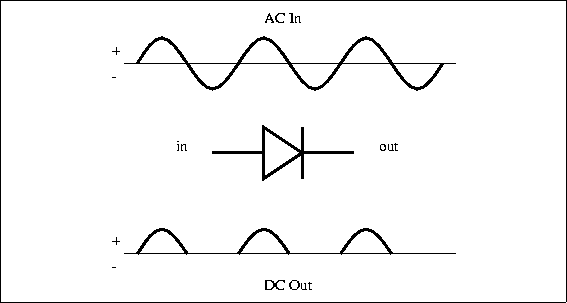Understanding Rectifier and Rectifier Circuits on Ship
Apart from their small size, all electrical and electronic equipment or circuit on boards on ship play a vital role in operation of ship’s system and machinery. Different equipment onboard vessel utilizes alternating current, direct current or both depending upon the nature of operation. Some of the Very important circuits and setups are run through D.C current.
Since most of the ship generates A.C current from its alternator, it becomes essential to use a device, along with transformer, which can convert this A.C current into D.C current for the use of those equipment or circuit running on D.C.
Rectifier
Rectifier is a circuit which utilizes one or more semiconductor diode to convert an alternating current into a pulsating direct current.
This process of conversion is known as rectification.

Types of Rectifier
Half wave rectifier
Half wave rectifier consists of a single diode connected in series with load resistor.

During the positive half cycle of input voltage, the diode is forward biased and it conducts for all volts which is greater than its barrier potential.
During negative half of the cycle, the diode is reverse biased hence it does not conduct.
Full wave rectifier
Full wave rectifier circuit allows unidirectional current to flow to the load during the entire input cycle.
There are two types of single full wave rectifier:
1) Two diodes connected back to back using a centre tapped transformer.
2) Full wave bridge rectifier using four diodes connected in the form of bridge.

Bridge rectifier
A single phase bridge rectifier is used with four diodes connected in bridge with a non centre tapped transformer. Full wave rectifier has an advantage of converting both polarities of input A.C waveform in to D.C, hence it is more efficient.
A three phase rectifier circuit consist of six diodes which are in pair of three, connected in series (anode to cathode). It is commonly used in three phase circuits.
Application onboard
Some of the uses of rectifiers on board ship are;
- Used in many marine electronic devices and circuits.
- They are used for onboard battery charging from the ship supply.
- Used in detection of radio signals.
- They can be used in electroplating process.
- They are used in ship construction for electrolyte refining of metals.
- Used in operation of D.C motor.
- Used in field excitation of three phase alternator.
You may also like to read- Operational Amplifier (op amp) & Electrical Safety Device: Air Circuit Breaker (ACB)
Do you have info to share with us ? Suggest a correction

About Author
An ardent sailor and a techie, Anish Wankhede has voyaged on a number of ships as a marine engineer officer. He loves multitasking, networking, and troubleshooting. He is the one behind the unique creativity and aesthetics at Marine Insight.
Subscribe To Our Newsletters
By subscribing, you agree to our Privacy Policy and may receive occasional deal communications; you can unsubscribe anytime.




Delightful, I passed this on to a friend of mine, and he actually bought me lunch because I found this for him, so let me rephrase: Thanks for lunch.
sir i will be join merchant Navvy in private man supply company (specific global) they are promise that they are give the job in Navvy
and fist our training is in bhuvneshvar(orissa)
it is TRUE or FALSE please sir give advice
i payed 4 lak Rs in simat university
It is better to directly join a reputed institute rather going through a third party. Their is always a risk.
can the ship sail if the rectifier is faulty ..